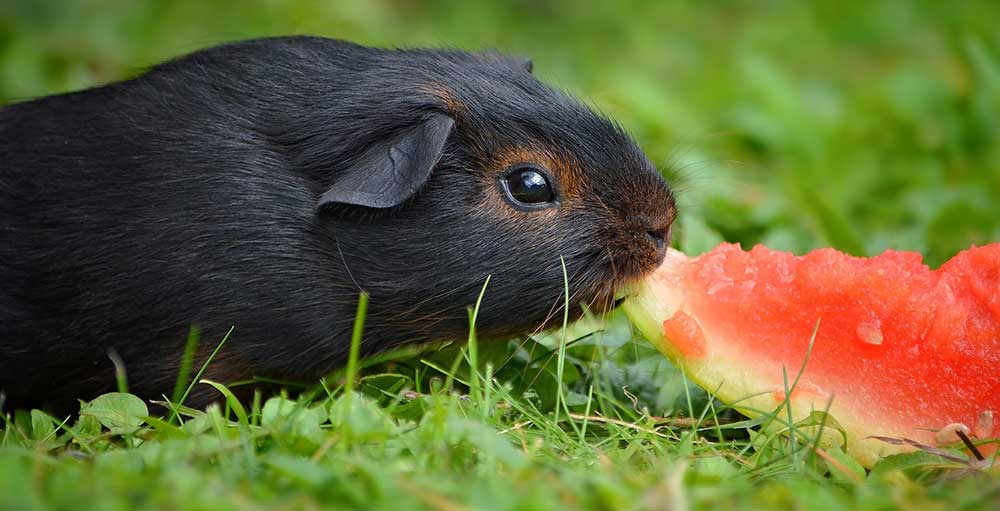
The part of guinea pig care that will affect the health of your guinea pig most is the food that they eat. Like many other small pets, guinea pigs are herbivores. They also have a sensitive digestive system that has specific nutritional and eating requirements to function properly. Following our recommended guinea pig diet will help your cavy maintain a healthy weight and prevent other health issues. It’ll also make for a happy and active piggy!
This article covers everything you need to know about feeding your guinea pig a healthy and nutritionally complete diet. We cover what foods they should eat and how much they should have, as well as recommending the best brands of guinea pig foods. The whole article is filled with important information for guinea pig owners, but if you’re looking for specifics on a particular part of cavy diets, use the contents link to jump to that section.
Contents
Guinea Pig Diet & Nutrition
To help ensure a long and healthy life for your pet guinea pig, you want to make sure to provide for them a daily diet that includes these key components:
- Fresh Water
- Grass Hay
- Guinea Pig Pellets
- Fresh Vegetables
- Vitamin C
Unlimited water and grass hay should be available to your guinea pig at all times. Usually, it’s easiest to provide cold, fresh water via a water bottle. Do not add vitamin C or other supplements to your guinea pig’s water (learn more about this in the section on Vitamin C for Guinea Pigs).
A guinea pig should also be fed a high-quality pellet daily to ensure they’re receiving the minimum necessary vitamin, minerals, and nutrients. The type of pellet given depends on a guinea pig’s age (see the next section on “Guinea Pig Age and Diet”). Fresh vegetables also help to round out a cavy’s diet, providing essential vitamin C and other nutrients.
While guinea pigs will get most of the nutrients they need from a good pellet and fresh vegetables, cavies cannot manufacture their own vitamin C, making them prone to scurvy. You may want to provide them with a vitamin C supplement to ensure consistency in their diet.
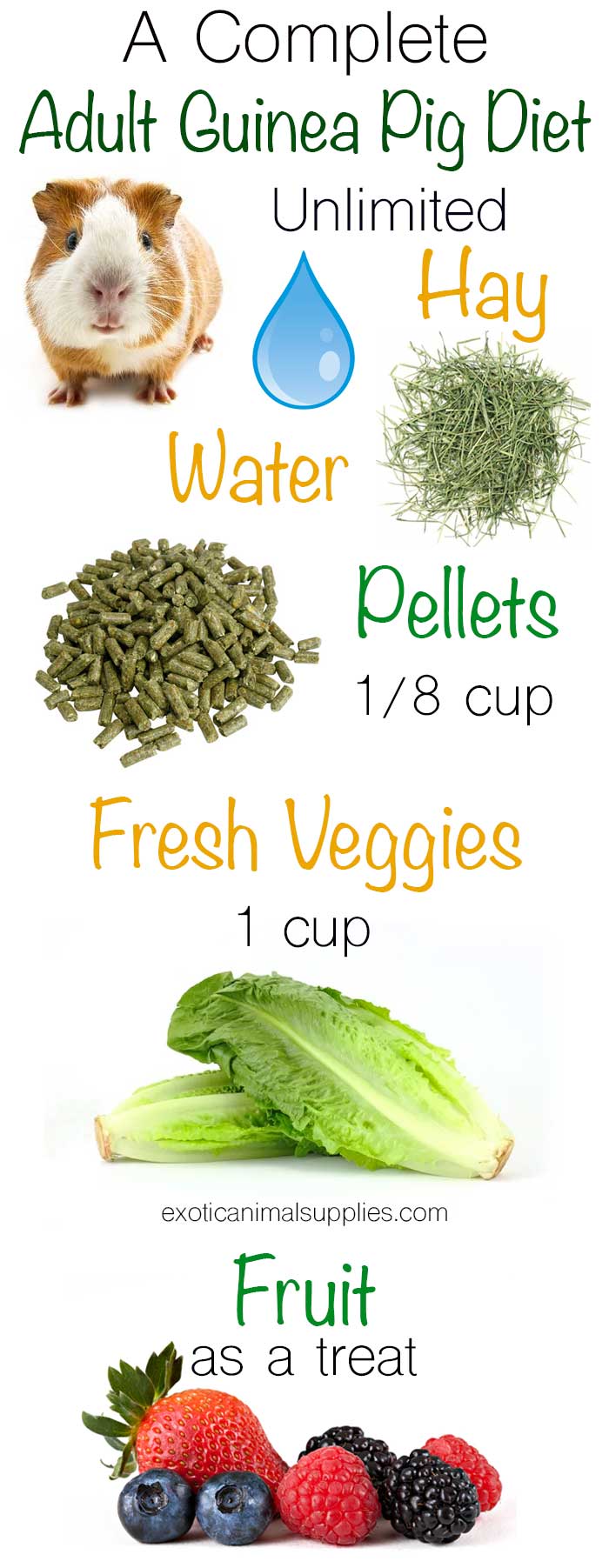
Guinea Pig Age and Diet
Baby and young guinea pigs have different dietary needs than adult cavies. Young guinea pigs that are still growing should eat an alfalfa-based pellet and can have alfalfa hay in addition to regular grass hay. Pregnant and nursing mothers should also eat a similar diet.
A guinea pig is considered “fully grown” once they reach six months of age. At that point, they should transition to an adult diet. Adult guinea pigs should have grass hay and a timothy hay-based pellet at the center of their diet. Alfalfa should only be given as a supplement if your guinea pig needs it or an occasional treat. The high calcium content can cause bladder stones in older guinea pigs.
Best Hay for Guinea Pigs
Hay is one of the most important parts of your guinea pig’s diet. This is because (like water) it should always be available for munching. A guinea pig’s digestive system is always moving, so they should have unlimited access to good quality hay to feed it. Eating hay also requires them to grind their teeth lightly, so it helps keep them from overgrowing as well. Hay is also essential for providing the necessary fiber needed by a piggy.
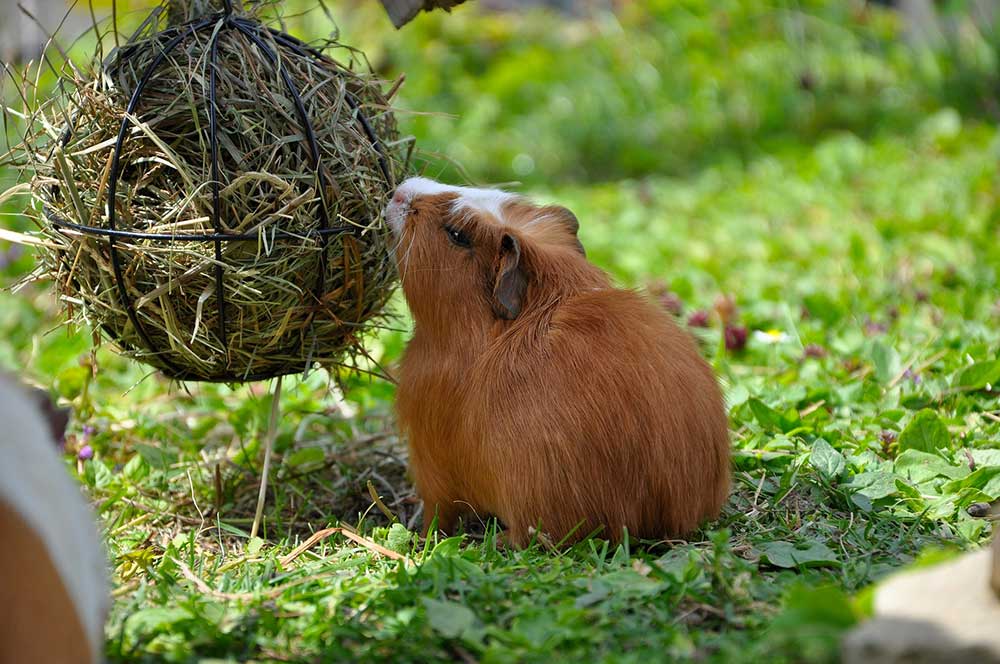
Most grass hays are similar in nutritional value. You may find your guinea pigs have a preferred variety. Feeding a mix is a great way to provide your guinea pig with variety and keep them from getting bored.
Recommend Guinea Pig Hay Types:
- Timothy
- Orchard Grass
- Meadow Hay
- Alfalfa Hay (under 6 months old only)
Alfalfa hay is only recommended for young guinea pigs or pregnant or nursing mothers. It can sometimes be given to malnourished adult piggies as a supplement, but should not be given as a replacement for grass hay. Alfalfa has high calcium content which can cause bladder stones in older guinea pigs.
You can purchase hay from pet stores or order them online. If you have the space to store it, buying in larger quantities is a great way to save money. Buying hay directly from a farm or feed store will cost less than hay from pet stores and the hay will also be fresher. When purchasing hay, make sure it is fresh. It should be green and smell fragrant, but not moldy.
You can provide hay in a wire or wooden hay rack to keep it clean and off the cage or pen floor.
Recommended Grass Hay Brands
Our recommendations include national brands you can find in pet stores or order on Amazon. We also have some farms that you can order from directly in larger quantities.
If you’re shopping for timothy hay for guinea pigs, you may have a choice of “cut” either first, second, or third cutting. These numbered cuttings refer to the crop of hay it came from during the growing season. Generally, the second cut is the best as it has a good balance of nutrients and fiber and is more uniform. Many owners prefer third cutting timothy hay, but it is rarer and during a bad season may not happen at all.
Oxbow Guinea Pig Hay
We are a huge fan of Oxbow, especially because they’re easy to buy for owners in the US. They are one of the best brands available in many pet stores and their hay is extremely easy to order online. They offer many varieties of hay that are great for small animals like guinea pigs. Their hay is grown in the USA and hand-selected to ensure a good quality product.
The options they offer for guinea pigs include:
- Timothy Hay (Check Price at Petco | Check price on Amazon)
- Orchard Grass (Check price on Amazon)
- Alfalfa Hay (Check Price at Petco | Check price on Amazon)
- Organic Meadow Hay (Check price on Amazon)
Small Pet Select
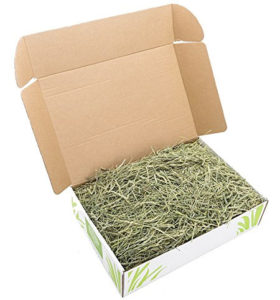 Small Pet Select is a great online distributer for hay for small pets. They only offer timothy hay and orchard grass, but both are a great option for guinea pigs.
Small Pet Select is a great online distributer for hay for small pets. They only offer timothy hay and orchard grass, but both are a great option for guinea pigs.
One thing that Small Pet Select does differently, is they pack and ship their hay in a cardboard box, which is a better long-term storage option for keeping hay than a plastic bag. They offer timothy hay in 1st, 2nd, and 3rd cuttings.
Check out their hay for Guinea Pigs:
- 2nd Cutting Timothy Hay (Check Price at Small Pet Select | Check price on Amazon)
- 3rd Cutting Timothy Hay (Check Price at Small Pet Select)
- Orchard Grass (Check Price at Small Pet Select | Check price on Amazon)
- Alfalfa Hay (Check Price at Small Pet Select)
Farmer Dave Pet Supply
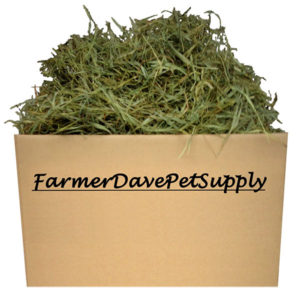 Farmer Dave is located in New York State and specializes in organic, high-quality pet supplies for small pet owners. His hay selection is unfortunately limited to timothy hay, but he offers it in 1st, 2nd, and 3rd cuttings. He also ships LARGE boxes of hay, great for guinea pig owners with a whole house of hungry piggies. Currently, he offers 10 lb., 25 lb., and 35 lb. boxes.
Farmer Dave is located in New York State and specializes in organic, high-quality pet supplies for small pet owners. His hay selection is unfortunately limited to timothy hay, but he offers it in 1st, 2nd, and 3rd cuttings. He also ships LARGE boxes of hay, great for guinea pig owners with a whole house of hungry piggies. Currently, he offers 10 lb., 25 lb., and 35 lb. boxes.
Fay’s Hay
 If you’re interested in buying guinea pig hay directly from a farmer but don’t need such large quantities, check out Fay’s Hay. Also located in New York State, Alicia Fay owns a small family farm that sells hay to large animal farms in the northeast. Now they offer their delicious guinea pig grass to small pet owners as well. All of their hay is pesticide and chemical-free, as well as naturally sun and wind dried on their farm.
If you’re interested in buying guinea pig hay directly from a farmer but don’t need such large quantities, check out Fay’s Hay. Also located in New York State, Alicia Fay owns a small family farm that sells hay to large animal farms in the northeast. Now they offer their delicious guinea pig grass to small pet owners as well. All of their hay is pesticide and chemical-free, as well as naturally sun and wind dried on their farm.
They only sell timothy hay and orchard grass blend that has a small amount of clover, but it is available in 1st and 2nd cuttings, or a mixture of the two. Available sizes include 1 lb., 5 lbs., 10 lbs., and 20 lbs.
Guinea Pig Pellets
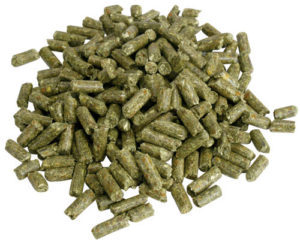 When you walk into a pet store, you’re immediately bombarded with tons of guinea pig food options. Nuts, seeds, and brightly colored pellets call out to you. It can be overwhelming. Guinea pigs can’t eat any of that, so your shopping is about to get a lot easier.
When you walk into a pet store, you’re immediately bombarded with tons of guinea pig food options. Nuts, seeds, and brightly colored pellets call out to you. It can be overwhelming. Guinea pigs can’t eat any of that, so your shopping is about to get a lot easier.
Guinea pigs should only eat a plain, dye-free high-quality timothy hay-based pellet formulated with Vitamin C (no nuts, seeds, or colored pieces). When selecting a guinea pig food, look for a pellet with stabilized vitamin C. Make sure to check the “Best by” date to make sure it is fresh and store it in a dark cool place to preserve the vitamin C. Avoid pellets with a primary ingredient or corn and any made from animal byproducts.
Each adult guinea pig should eat approximately 1/8 a cup of pellets per day. As long as you are providing plenty of fresh hay and adequate vegetables (more on this in the next section), your piggies should not overeat.
Many guinea pig pellets are alfalfa based. These types should only be given to guinea pigs under 6 months of age or pregnant piggies.
Recommended Healthy Pellet Brands for Guinea Pigs
Choosing a proper guinea pig pellet will ensure your cavy is getting the minimum daily requirements for vitamins, minerals, and other nutrients in their diet.
Oxbow Essentials Adult Guinea Pig Pellets
It’s no surprise that Oxbow shows up in the article again! Available in many US pet stores and easy to order online, Oxbow also makes one of the best guinea pig foods available. Formulated especially for adult guinea pigs, this pellet is timothy hay based and fortified with stabilized vitamin C. They’ve formulated it to be lower in protein, calories, and calcium so it is healthier and won’t cause any problems for full grown piggies.
Sizes: 5 lbs, 25 lbs
Oxbow Essentials Young Guinea Pig Food
If you’ve got younger piggies to care for or pregnant or nursing mother, Oxbow makes a young guinea pig pellet. Similar to their adult food, these pellets are fortified with stabilized vitamin c, but the base is alfalfa.
These can be fed in unlimited quantities to piggies under 6 months old and pregnant or nursing mothers.
KMS Hayloft Guinea Pig Timothy Choice Pellets
If your piggies turn up their wiggly noses at Oxbow, KMS Hayloft pellets are an excellent alternative. Though you have to order them online. KMS Hayloft provides high quality pellets made from natural ingredients.
Designed for adult guinea pigs over six months of age, the timothy based pellets are infused with stabilized vitamin C. KMS Hayloft makes the pellets in small batches, so you know you’re getting a fresh batch when you order.
Healthy Veggies & Fruits for Guinea Pigs
Fresh vegetables are another essential part of a guinea pig’s diet. They’re a great source of vitamin C as well as providing a variety of other nutrients.
An adult guinea pig should eat about 1 cup total of vegetables per day. It’s best to provide veggies two or more times a day, making sure to remove uneaten vegetables from their enclosure.
Green leafy vegetables should make up the majority of each day’s “salad.” Fruits should be a small part of their diet, given sparingly as a treat. Check out our recommended fruit and veggie lists below.
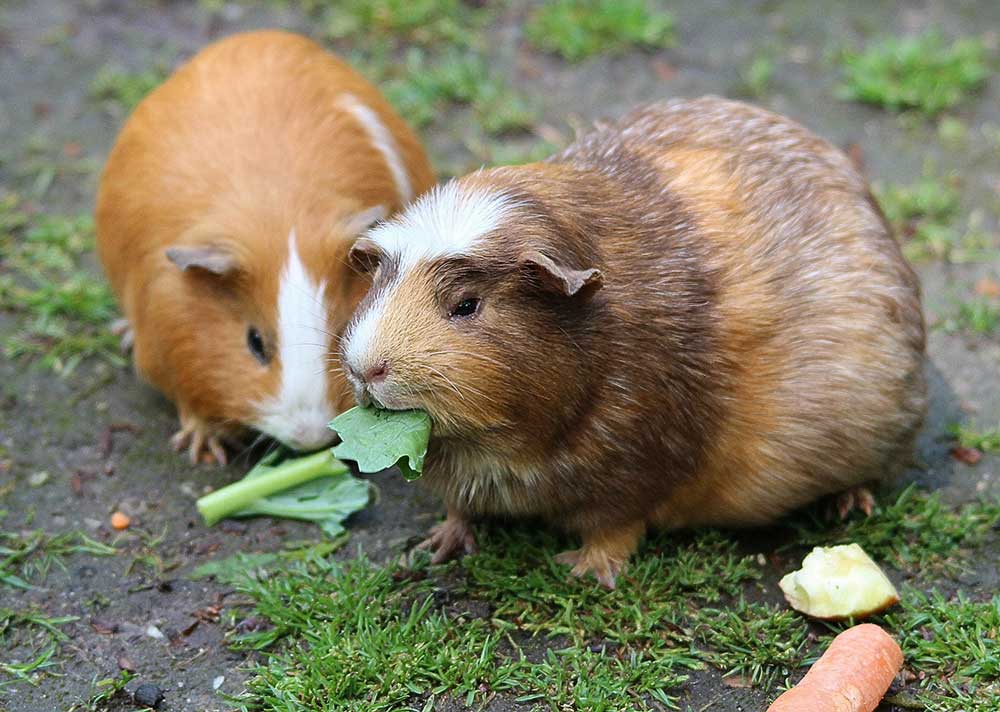
Each cavy has their own preferences and you will soon learn what veggies make them wheek with joy and which ones will be ignored. Guinea pigs enjoy variety, so make sure to mix up their “salads” occasionally to keep them interested. This will also ensure they’re getting a variety of nutrients in their diet.
Make sure to rinse vegetables thoroughly before you feed them to your guinea pig. Avoid feeding them wilted or spoiled veggies. Choose organic fruits and vegetables if you can afford them (or grow your own!).
A Note on Introducing New Foods to Your Guinea Pig: Cavy stomachs are delicate and they need to be introduced to new foods very slowly and only one new food at a time. When you introduce a new food, monitor their stool. If they have softer stools that persist over a couple days, do not continue the new food. Even though these lists include vegetables that are safe for guinea pigs, your piggy may not tolerate it or even like the veggies! Keep a list of their favorites to make shopping easy. If you have questions or concerns about your piggy’s diet, consult with a guinea pig-savvy veterinarian.
Leafy Greens
These should be the main part of your guinea pig’s veggie diet. Avoid watery lettuces, like iceberg lettuce, which are low in nutrients and can cause loose stools.
Greens with an asterisk* should only be fed occasionally.
- Arugula (Rocket)
- Chinese Cabbage (pak-choi)*
- Grass (fresh and pesticide free)
- Green Leaf Lettuce
- Kale
- Red Leaf Lettuce
- Romaine Lettuce
- Wheat Grass
Other Veggies
Vegetables with an asterisk* should only be fed ocassionally
- Baby Carrot (every other day)
- Basil
- Broccoli Leaves*
- Celery (cut in small pieces)
- Chickweed (fresh)
- Cilantro
- Corn Silks & Husks*
- Cucumber
- Dandelions (fresh high in calcium)*
- Dill
- Green Bell Pepper (1/8 to 1/4 a pepper)
- Lemon Balm
- Mint
- Parsley (high in calcium)*
- Peeled Broccoli Stem*
- Tomato (wedge or 1 cherry tomato)
- Young Clover (fresh high in calcium)*
- Zucchini
Fruits
Fruits should be given sparingly because of their high sugar content.
- Apples
- Banana
- Blackberries
- Blueberries
- Cantaloupe
- Cranberries
- Grapes
- Raspberries
- Strawberries (can eat leaves too)
- Watermelon
Veggies to Avoid
These items should be avoided in your guinea pig’s diet or fed in very small quantities. Any indicated with an asterisk* should not be fed to your cavy.
- Broccoli (causes gas)
- Brussels Sprouts (causes gas)
- Cabbage (causes gas)
- Cauliflower (causes gas)
- Iceberg Lettuce*
- Potatoes (especially not skins and eyes)*
Vitamin C for Guinea Pigs
Because guinea pigs do not manufacture their own vitamin C they are at risk of developing scurvy. Unlike old-timey pirates, you can easily prevent the condition in your pet by providing 10 to 30 mg/kg of vitamin C daily. Savy pet parents can easily provide this in the form of a healthy pellet diet and fresh vegetables, but you may want to use supplements to make sure your cavies get enough. We highly recommend providing a supplement for sick, young, nursing, and pregnant piggies since they need extra vitamin C.
Do not add vitamin C to your guinea pig’s water. This is often recommended by pet store employees, but overall is a bad choice for your pet. First, it makes it hard to monitor how much vitamin C your guinea pig gets, because each of your piggies may drink different amounts of water. Once the drops are added to the water, the ascorbic acid (water-soluble vitamin C) breaks down quickly, so your guinea pig won’t get the benefits. The drops also change the flavor of the water, which may make your pets drink less water.
Instead, we recommend either giving them a piece of a vitamin C tablet (25 mg worth of a chewable vitamin C tablet) or feeding them vitamin C drops directly. We recommend buying a 100 mg chewable vitamin C tablet. Cut it into quarters and give one to your guinea pig. Check your local health food stores for vitamin C in liquid form.
Guinea Pig Treats
This is another way that pet stores fail guinea pig owners. Walk down the aisle and you see tons of prep-packaged treats advertised for guinea pigs. And all of them are terrible for your beloved pets!
The only treats you should be feeding your guinea pigs are fresh veggies and an occasional small piece of fruit.
Do not feed yogurt drops, nut and seed treats, popped grains, “fiesta” toppers, or salt and mineral wheels.
Transitioning Guinea Pigs to New Foods and Diets
Sudden changes to your pet’s diet can cause illness and stomach issues. It’s good to gradually introduce them to new pellets, veggies, and fruits so you can monitor their reactions. It’s not uncommon for a diet change to cause soft poops (especially with fresh fruits and vegetables), but if it persists for more than a day, stop giving them the new food.
You should only introduce one new type of food at a time. This will make it easier to identify what food may be causing problems and help avoid upsetting your piggy’s tummy.
Introducing New Fruits & Vegetables to Your Guinea Pig
Guinea pigs are healthiest and happiest with variety in their diet. A varied “salad” each day will help keep them interested and ensure they’re getting a variety of nutrients.
To introduce new veggies to their diet, only add one at a time. Give them the new vegetable or fruit for three days in a row and monitor their stool. If you notice softer or runny stools, stop the new food. If after three days there’s no change in their poop, you can add the item to their regular salad rotation.
During this experimentation, you’ll probably discover there are some veggies your guinea pig doesn’t like. This is just a matter of personal taste, but experimenting like this will help you figure out what foods they like. Keep track of their favorites and it will help you plan a diverse fresh guinea pig diet.
Transitioning to New Guinea Pig Pellets
Consistency is best in a guinea pig’s diet. Once you have your piggies eating a pellet that is healthy and easy for you to buy, you hopefully won’t need to change it. When your guinea pig first comes home you may need to change their pellets to a healthy choice.
Changing a guinea pig’s pellets should be a slow transition while you’re not making any other changes to their diet. Make sure you have enough of the old guinea pig food on hand to get through the transition period. While you’re changing your piggy’s food, keep an eye on their poops to make sure it’s not getting soft or mushy.
The best way to transition guinea pig pellets is over a three week period. Follow this schedule:
- Week 1: Feed 75% of the old pellets and 25% of the new pellets each day.
- Week 2: Feed 50% of the old and 50% of the new pellets each day.
- Week 3: Feed 25% of the old and 75% of the new pellets each day.
- Week 4: If yourguinea pig has no problems, feed the new pellets exclusively.
Occasionally your guinea pig may refuse to transition to a new pellet (especially if they were previously eating an unhealthy “junk mix”). They may pick out the old pellets and leave the new ones uneaten. In this case, you may want to continue feeding the old food (as long as it is healthy) or try a different brand.
Use this infographic as a handy guide:
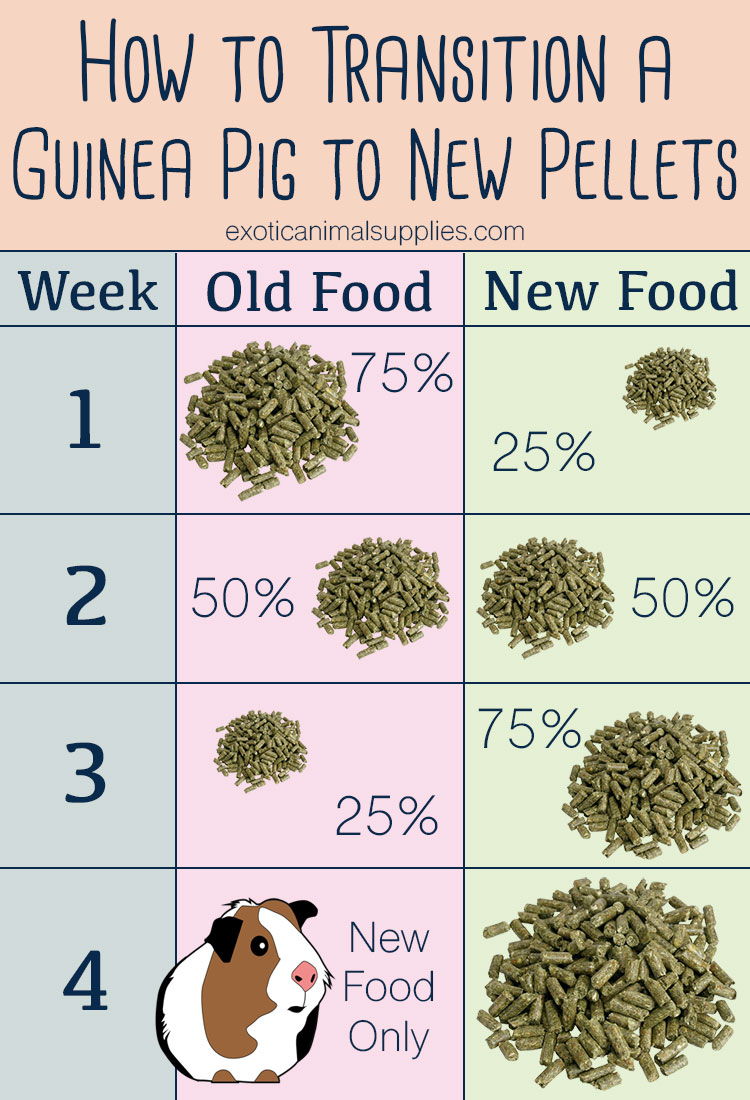
Learn how to grow a guinea pig garden for fresh vegetables at home.




